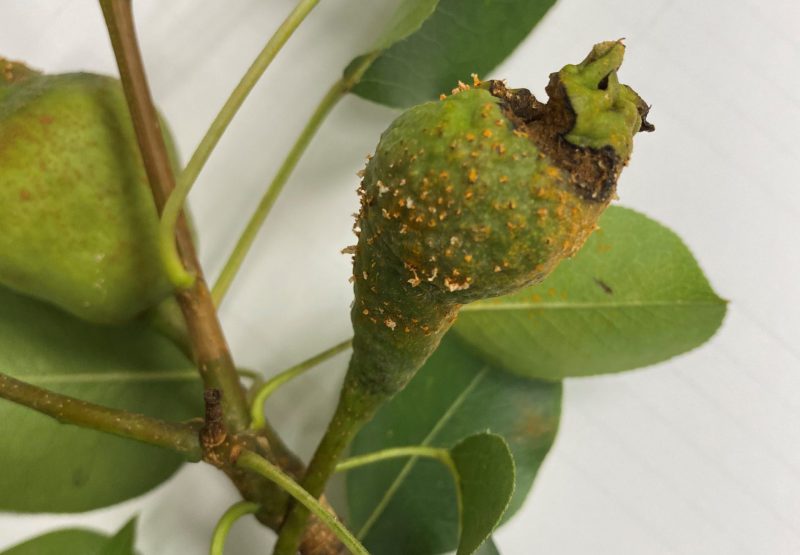This past week has been dry, but we’ve already had an abundance of rain this year. Wet conditions are conducive to fungal disease. One disease that is starting to show up is cedar apple rust.

Cedar apple rust on a young pear. Photo Credit: Matt Lollar, University of Florida/IFAS Extension – Santa Rosa County
–
As you would expect, cedar apple rust is a member of the rust family. Members of this fungal family are a reddish orange during some parts of their life cycles. Cedar apple rust requires two or more host plant species to complete its life cycle. A juniper species (usually eastern redcedar) and a species in the rose family (usually apple, pear, or mayhaw) are required. The life cycle begins with the production of teliospores on golf ball sized growths on a juniper species. The teliospores produce structures called basidia which can be blown two to three miles in the wind. After landing on an alternate host, the basidia spores germinate and form reddish orange spots on leaves and fruit of members in the rose family.

A mature gall, extruding gelatinous tendrils of spores, produced by Gymnosporangium juniperi-virginianae on an eastern redcedar (Juniperus virginiana). Photo Credit: University of Massachusetts Amherst
–
There are a number of control measures that can be implemented for this disease.
Cultural Control
- Remove and destroy infected leaves, branches, and fruit from all affected species.
- Remove all juniper species surrounding the orchard.
- Do not plant susceptible species near the orchard.
- Prune fruit trees to promote airflow to the interior leaves and branches.
–
Chemical Control
- Fungicides should be applied before leaf spots or fruit infection occurs.
- Fungicides containing the active ingredient myclobutanil are the most effective.
- Start spraying fungicides when flowers start to emerge, and make additional applications throughout the growing season.
- Crops to Consider for Fall Planting - September 26, 2025
- Benefits of Manure Fertilizers and Analysis - March 21, 2025
- Mushrooms – A Crop Worth Consideration for the Back Forty - October 4, 2024
